P = Σ(xi) = 5Σgi + Σei
where
gi = 0, 1, 2, 3, 4, 5 (group)
ei = −2, −1, 0, +1, +2
There are good similarities among three different pip counting systems, Douglas Zare's "Half-Crossover Pipcount", Nack Ballard's "Naccel", and my system. Those three systems separate all 26 points of the board in a number of groups, assign a group center, and provide error numbers from the center point to locate any points in a group.My system, the "Five-Count," is described here.
A detailed explanation for Douglas Zare's "Half-Crossover Pipcount" is available at this link
Nack Ballard's "Naccel" is explained in a GammOnLine article. Note that the "Naccel" shown in GammOnLine is slightly different from the one explained in Backgammon Today Sep. 2001 issue, but is the "bumped" one introduced in the magazine. The "Naccel" I referred in this page is the one with not bumped quads (the 6 point has 6 extra pips.)
To show "summation" operation, I use a "sigma" sign, Σ, as follows:
| 15 | ||||
| Σai | = | Σai | = | a1 + a2 + a3 + ... + a14 + a15 |
| i=1 |
I also use these symbols:
| xi | = | A pip count of a checker located any point. i = 1, 2, ... , 15 |
| P | = | A total pip count. |
xi = 5gi + ei
P = Σ(xi) = 5Σgi + Σei
where
gi = 0, 1, 2, 3, 4, 5 (group)
ei = −2, −1, 0, +1, +2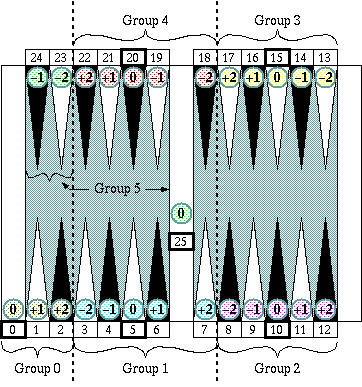
xi = 5 + 3hi + ei
P = Σ(xi) = 75 + 3Σhi + Σei
where
hi = −2, −1, 0, 1, 2, 3, 4, 5, 6, 7 (half crossover)
ei = −1, 0, +1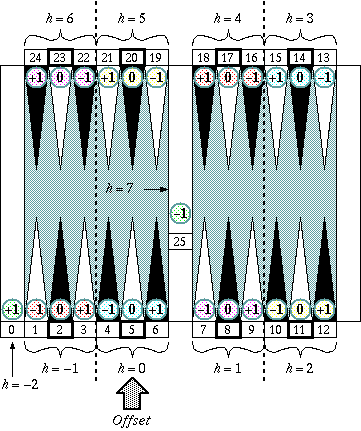
Note: the error number of the goal point (or the pocket) is +1 of h = −2.
xi = 6qi + ei
P = Σ(xi) = 6Σqi + Σei
where
qi = 0, 1, 2, 3, 4 (quad)
ei = +1, +2, +3, +4, +5, +6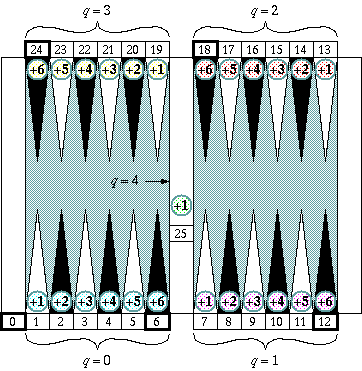
Since all ei is positive (+) and Σei often becomes too big to handle for a human player, another breakdown in the Σei part is called for:
Σei = 6s + r
P = 6(Σqi + s) + r
where
s = 0, 1, 2, ..., 15 (squad)
r = 0, 1, 2, ... (remains, usually r < 6)
xi = 6qi + ei
P = Σ(xi) = 6Σqi + Σei
where
qi = 0, 1, 2, 3, 4 (quad)
ei = 0, +1, +2, +3, +4, +5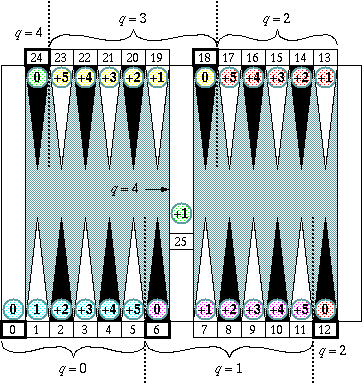
xi = 6 + 6qi + ei
P = Σ(xi ) = 90 + 6Σqi + Σei
where
qi = −1, 0, 1, 2, 3
ei = 0, +1, +2, +3, +4, +5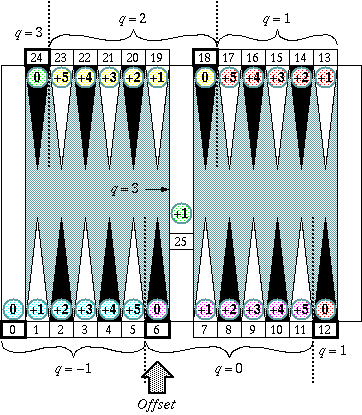
xi = 6 + 6qi + ei
P = Σ(xi ) = 90 + 6Σqi + Σei
where
qi = 0, 1, 2, 3
ei = 0, +1, +2, +3, +4, +5 (for qi = 1, 2, 3)
ei = −6, −5, ... , −1, 0, +1, ... , +5 (for qi = 0)
Note: the error number of the goal point (or the pocket) is −6.
xi = F + Bgi + eiP = Σ(xi ) = 15F + BΣgi + Σei
Parameters B
(base)F
(offset)gi (group) ei (error) Five-Count 5 0 0, 1, 2, 3, 4, 5 −2, −1, 0, 1, 2 Half-Crossover 3 5 −2, −1, 0, 1, ... , 7 −1, 0, 1 Naccel 6 0 0, 1, 2, 3, 4 1, 2, 3, 4, 5, 6 Bumped Naccel 6 0 0, 1, 2, 3, 4 0, 1, 2, 3, 4, 5 HN Naccel 6 6 −1, 0, 1, 2, 3 0, 1, 2, 3, 4, 5, HF Naccel 6 6 0
1, 2, 3−6, −5, −4, ... , 4, 5
0, 1, 2, 3, 4, 5
See: Other articles by Sho Sengoku
See: Other articles on Pip Counting
Return to: Backgammon Galore : Articles